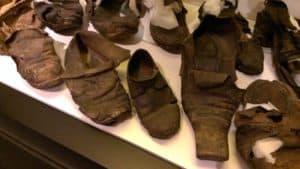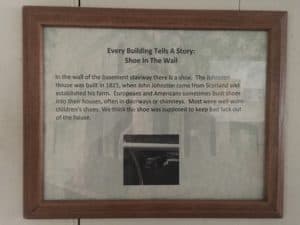Concealed Shoes
By Amy Pepe, Visitor Services and Public Programs Manager at Rose Hill Mansion and Johnston House
Along the basement stairs at the Johnston House is an unusual, but not altogether unique, artifact sealed inside the wall: a single shoe. The phenomenon of concealing shoes inside the walls of a house spans continents and dates back centuries. The earliest known example of shoe concealment is in a wall at Winchester Cathedral in England that was constructed in 1308. However, the practice became most widespread in the 19th century, slowly ceasing by the 1930s. According to the index of concealed shoes kept by England’s Northampton Museum , the majority of concealed shoes have been found in England and to a lesser degree across the UK, Australia and North America.
Concealed shoes were thought to be a “good luck charm” of sorts; to ward off evil spirits from inhabiting a new structure and possibly also as a fertility charm. Most often, the concealed shoe is a single shoe, extremely well worn as most people would not have been able to afford to seal away a brand new shoe before wearing it. About half the time the concealed shoe is a child’s shoe, perhaps because children wore out and grew out of their shoes much faster than adults. While shoes would have been repaired multiple times during their life of use, concealed shoes also show evidence of being repaired specifically for placement in a wall. The belief was that a repaired shoe was a better vessel or talisman to protect against evil.
The most common places for a shoe to be concealed are the chimney, fireplace, above doorways, under the floor, or in the roof. The shoes were typically placed in a part of the house seen as most vulnerable or weak to unwanted forces. Not as common is concealing a shoe in the basement or in the stairs, as we see at Johnston House.
Other items historically concealed in walls as good luck charms include animal skulls, bottles, and written charms, although shoes are by far the most common item. One theory is that shoes are one of the few items that retains the imprint or shape of its owner, thereby making it a more personal and powerful symbol of protection and luck.

A collection of concealed shoes from England
The Johnston’s were Scottish immigrants and likely brought the tradition of concealing shoes with them to New York when they built their home here in 1821. Some scholars theorize that concealing a shoe or other pieces of clothing may have been an offering to domestic fairies or spirits such as the brownie or the hob, which people held strong superstitions in Scotland and England. Come visit Johnston House in May through October this year to see the site of the concealed shoe for yourself.


Fàscinating story. Thank you, Amy.
Great story. Never knew about this tradition. Thank you for good research.